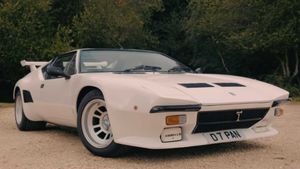
You should never fear working on your old classic car – here's why it's good for the soul...
When you sit in the driving seat, do you know what mechanicals you happen to have around you and how they work? Do you know how many cylinders are in your engine and whether you’re using front or rear wheel drive? If you’re a classic car owner, chances are you’re shouting a resounding yes back at me!
However, to my astonishment, there are a surprising number of motorists out there who don’t have a clue. These are the drivers who think dealing with an unexpected fault in their car involves speed-dialling the breakdown services and sitting roadside waiting for assistance. Really? Is that what we’ve come to? Henry Ford is spinning in his grave at 5000rpm.
I’ll hold my hands up and confess that when I bought my Standard 8 – lovingly nicknamed 'Henry' – I was not blessed with an encyclopaedic understanding of what lay underneath a car’s bonnet, nor how to fix it should strange noises occur. If the classic Standard spat oil or hot water at me or brought my journey to a complete grinding halt, I was a tad stuck.

I did however know what the different parts of the car were called and roughly what they did. I knew from my many Nürburgring laps on the Playstation that I seemed to have a preference for rear-wheel-drive saloons, even though I didn’t have a clue as to why!
Despite this, I was still further ahead than most. As a new driver, I was keen to engage with anyone willing to talk cars. To my disappointment, once I got going, I often realised the person I was speaking with wasn’t entirely following what I was saying.
Words like 'magneto' or phrases such as 'flooded carburettor' resulted in blank stares coming back at me. Sorry ladies, but I’m rather tired of being told your car is just to get you ‘from A to B’ and how is that stuff interesting anyway. Motoring is a fabulously emotive pursuit where we combine our best ideas in design and technology into taking us to the places we want to go. To love driving is to love being alive, or is that just me?

There was a notable amount of adjusting to do when I migrated from driving lessons in a modern BMW Mini to trying to start a 1957 saloon with a choke and no synchromesh on first gear. Surprisingly I didn’t find this too difficult. In fact, I felt entirely at home within a 1950s saloon’s interior.
I had to push and pull metal knobs on the central section of the dashboard to control things like the wipers, heater and lights. I had to stamp on a metal button on the floor just above the clutch pedal to select main beam. The gear changes had to be made in line with the revs with long sweeping thrusts of my left arm. I had to patiently wait for the glass inners of the old radio to warm up before it would deliver any sound.
It all felt remarkably natural and I got to adore the older driving style. Waves of nostalgia would hit me as I travelled, to the point of being able to bring me to happy tears, as if I’d done it all before.

What was tricky was adapting to the speed of modern motoring, keeping to a pace that those in new cars expected as they drove behind and alongside me. I was quick to learn that I had to have eyes everywhere and think much further ahead than those around me. With a top speed of 60mph, joining a busy motorway from a slip road usually felt somewhat suicidal!
I also learned that my journey might start at A but wouldn’t always finish at B. A.5 became a happy target. As time and mileage started to pass by, my Standard started to point out that it needed much more maintenance than a modern car. My hands regularly got dirty, be it a spark plug change here or an oil top-up there. Weekends were spent washing the salt off the steel chassis and working my way around the various grease points. There were so many I needed a chart on my garage wall to help me learn where they all were!
At times, my regular servicing still wasn’t enough. I learned I also needed mechanical sympathy. I constantly had to read my car’s behaviour. My nose would tell me if the car was driving hot while spotting a few drips of fuel on the tarmac would suggest either a slightly blocked carburettor or a fuel-air mixture that was too rich.

Unless I was in a particular hurry, I actually enjoyed breakdowns. They were an opportunity to learn. Grown ups would cast me odd looks as I pushed the car to somewhere more appropriate for mechanical woes or as I fetched a spanner from the boot. Without realising it, I’d become the same oddity that my car was in the modern day.
My classic and I thoroughly bonded in those early years. At times I was prone to thinking that the car had kept going because I’d said ‘Not here Henry, not now.’ I talked to my car a lot when I was young! I never got an answer back in words but without realising it, in those conversations, I was actually learning how to read what a car had to say back through its engine note and general running.




